SAAB JAS-39 (A,B,C,D) "Gripen"
(Version 1.01 -
Last updated:
07/16/04)
- Background and RPG stats by Kenneth Olson
- Artwork by Ted Nomura, Pat Kelley, Pat Thornton, Katie
Gillette, Ben Dunn
- Published in Antarctic Press Robotech #7 and #8
BACKGROUND
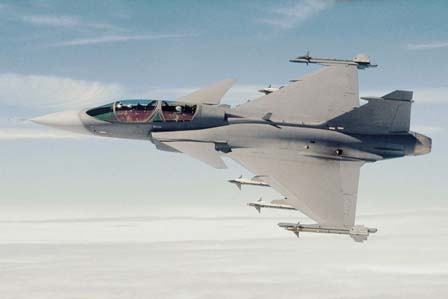 The JAS-39 "Gripen" was designed in the mid 1980's
to replace the aging Viggen and Drakens fighters and provide the first
"fourth-generation" multi-strike fighter to the Swedish Air
Force. As with all Swedish fighters, the Gripen is designed to
use small low-tech airbases scattered around the countryside and
take-off and land in less than 800 meters of unimproved automobile
roadways. The resultant fighter uses advanced avionics and the
close-coupled canard wing configuration common to the multinational
Euro-fighter, French Rafale, and the aborted Israeli Lavi. The
Gripen is composed primarily of a carbon-fiber composite construction
which makes up 25 percent of the airframe weight. The
design is not as stealthy as some other 4th generation fighters;
however, the fighters small size and reduced signature intakes have
reduced its overall radar cross section.
The JAS-39 "Gripen" was designed in the mid 1980's
to replace the aging Viggen and Drakens fighters and provide the first
"fourth-generation" multi-strike fighter to the Swedish Air
Force. As with all Swedish fighters, the Gripen is designed to
use small low-tech airbases scattered around the countryside and
take-off and land in less than 800 meters of unimproved automobile
roadways. The resultant fighter uses advanced avionics and the
close-coupled canard wing configuration common to the multinational
Euro-fighter, French Rafale, and the aborted Israeli Lavi. The
Gripen is composed primarily of a carbon-fiber composite construction
which makes up 25 percent of the airframe weight. The
design is not as stealthy as some other 4th generation fighters;
however, the fighters small size and reduced signature intakes have
reduced its overall radar cross section.
The initial flight of the Gripen occurred on
December 9, 1989 and proved
so successful that the Swedish Air Force ordered 500 aircraft in light
of the deteriorating global situation prior to the Global Civil War.
One year before the start of the Global Civil
War in January of 1992, Eastern Co-Prosperity countries were able to
persuade neutral Sweden to buy nearly 200 fighters in exchange for
guarantees of territorial security. Nearly 175 Gripens were
delivered prior to the start of hostilities at
which point deliveries stopped; however, during the war the Gripen
showed that the fighter was equal to its contemporary light multi-role
fighters such as early model F-16 and F/A-18 fighters.
The Gripen was designed to use a wide variety of weapons from both
Western Alliance and Eastern Co-Prosperity arsenals. On
single-seat versions of the Gripen, a Mauser BK-27 27mm cannon is
mounted in the
fuselage underneath the left air intake. The cannon is capable of
firing up to 6,500 rounds
per minute with a muzzle velocity in excess of 1250 meters per
second fed from an internal 120 round storage drum. Up
to 7,942 lb (3,600 kg) of external stores can be mounted on two
wingtip, two wing, one centerline, and one below the starboard air
intake harpoints (total of six). Each hard point can mount short
range missiles (such as the AA-8, AA-11, AIM-9, or ASRAAM), a single
medium range or
long range missile (such as the AA-10, AA-12, AIM-120, or AMRAAM), or up to 500
kg of fuel, equipment or ordinance. The fighter is equipped with the
Ericsson SAAB PS-05A multi-role radar in the nose of the Gripen can be operated in either high or medium PRF air-to-air
search or a low PRF mode to be used in air-to-ground missions.
All modes can be selected through the HOTAS switch.
After the crash of the SDF-1 and subsequent end of
the Global Civil War, the formerly neutral Sweden was an early member
of the United Earth Government (UEG) and was given access to key
advanced technologies from the SDF-1. This allowed SAAB engineers
to provide a second generation Gripen with advanced alloys which
provide greater protection from enemy weaponry and resulted in new
over-technology turbojet design with vastly improved fuel economy and thrust to
weight ratios over the older models. The PS-05A
radar was replaced with an active, electronically scanned antenna
(AESA) which could be mechanically gimbaled. This allows the
system to scan ±60 degrees electronically and if needed an additional
±60 degrees mechanically. The newly designed JAS-39
(C,D) models
entered into production in 2010 and continued until the end of the
First Robotech War in 2011 during which time nearly 325 advanced units
were produced.
Nearly the entire Swedish air force was destroyed
during the Zentraedi bombardment of the planet and only 137 Gripens survived. The UEG
decided to upgraded all the surviving aircraft to
the more advanced -C/D and this work was completed in 2015. The Gripen saw
little combat use in the interlude between the 1st and the 2nd Robotech Wars and
eventually all the UEG Gripens were placed into reserve by 2027. There was some interest at the start of the 2nd Robotech
War to upgrade the remaining 75 units which had been placed in
mothballs; however, the costs proved too prohibitive and the entire
fleet remained in the UEG aircraft bone yard throughout the
conflict. There were several reports of Gripens being used by
resistance groups during the 3rd Robotech War. Although these
reports were never confirmed, the Gripens ability to use small stretches
of highway to take-off and land and coupled with the fact that the
Gripen uses a conventional power plant would make the fighter desirable
to resistance groups.
RPG STATS
- Vehicle Type: SAAB JAS-39 "Gripen"
- Class: Multirole strike
aircraft
- Manufacturer: SAAB-Scania
Crew: One Pilot (A,C), two pilots (B,D)
- Service History:
- JAS-39 (A,B): Single (two) seat multi-role strike
aircraft, served with Sweden from 1992-2010 and with Eastern
Co-Prosperity Sphere from 1994-2010
- JAS-39 (C,D): Single (two) seat multi-role strike
aircraft, served with Sweden from 2002 until 2010 and with the United
Earth Defense Forces from 2002 until 2010
-
MDC BY LOCATION:
| Location |
JAS-39 (A,B) |
JAS-39 (C,D) |
| 1
Pilot's Cockpit |
30/35 |
50/60 |
| Front Stabilizers (2) |
10 each |
25 each |
| 2
Wings (2) |
25 each |
50 each |
| 2
Tail |
15 |
30 |
Engine
|
15 each |
35 each |
| Ventral 35mm Cannon |
10 |
25 |
| 1
Main Body |
40 |
80 |
NOTES:
- Destroying the MDC of the main body or the Pilots Compartment
will destroy the mecha
- Destruction of either of the wings or tails will send the Gripen
into and uncontrollable spin
SPEEDS:
-
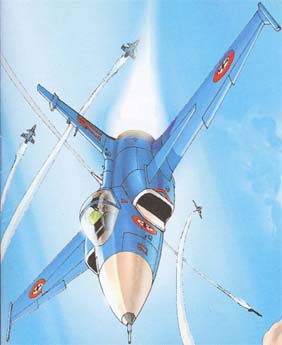 MAXIMUM SPEED:
MAXIMUM SPEED:
- JAS-39 (A): 1100 kph (Mach 0.9) at sea level and 2150
kph (Mach 1.97) at 30 kft
- JAS-39 (B): 1050 kph (Mach 0.86) at sea level and 2025 kph
(Mach 1.86) at 30 kft
JAS-39 (C): 1300 kph (Mach 1.06) at sea level and 2525 kph (Mach
2.31) at 30 kft
JAS-39 (D): 1220 kph (Mach 1.0) at sea level and 2350 kph (Mach
2.15) at 30 kft
- CRUISE SPEED (max performance without afterburner):
- JAS-39 (A): 1000 kph (Mach 0.92) at 30 kft
- JAS-39 (B): 900 kph (Mach 0.82) at 30 kft
JAS-39 (C): 1400 kph (Mach 1.28) at 30 kft
JAS-39 (D): 1100 kph (Mach 1.01) at 30 kft
- STALL SPEED:
- JAS-39 (A): 180 kph
- JAS-39 (B): 190 kph
JAS-39 (C): 170 kph
JAS-39 (D): 180 kph
- CLIMB RATE:
- JAS-39 (A): 5,000 meters per minute
- JAS-39 (B): 4,500 meters per minute
JAS-39 (C): 6,000 meters per minute
JAS-39 (D): 5,500 meters per minute
- CEILING:
- JAS-39 (A): 16,000 m (52.5 kft)
- JAS-39 (B): 15,700 m (51.5 kft)
JAS-39 (C): 18,500 m (60.7 kft)
JAS-39 (D): 17,250 m (56.5 kft)
- MIN TAKE-OFF DISTANCE:
- JAS-39 (A/B): 800 meters
- JAS-39 (C/D): 650 meters
- MIN LANDING DISTANCE:
- JAS-39 (A,B): 600 meters with drag chute
- JAS-39 (C,D): 550 meters with drag chute
- DESIGNED G LIMITS:
- +9.0 to -3.0 g
- RANGE:
-
- Nominal: JAS-39(A) - 1,600 km, JAS-39(B) - 1,450
km, JAS-39(C) - 2,100 km, JAS-39(D) - 1,911 km
- Maximum / Ferry: JAS-39(A) - 3,000 km, JAS-39(B)
- 2,718
km, JAS-39(C) - 3,938 km, JAS-39(D) - 3,583 km
- Low Altitude: JAS-39(A) - 960 km, JAS-39(B) -
870
km, JAS-39(C) - 1,260 km, JAS-39(D) - 1,147 km
STATISTICAL DATA:
- LENGTH:
- 14.1 m (A,C)
14.8 m (B,D)
- WINGSPAN:
- 8.4 m
- HEIGHT:
- 4.5 m
- WEIGHT (DRY):
-
- Dry: JAS-39(A) - 6,622 kg, JAS-39(B) - 6,850
kg, JAS-39(C) - 6,250 kg, JAS-39(D) - 6,350 kg
- Max Take-Off: JAS-39(A) - 12,500 kg, JAS-39(B)
- 13,100 kg, JAS-39(C) - 14,250 kg, JAS-39(D) - 14,750 kg
- ENGINE THRUST
- JAS-39 (A,B):
1 x General Electric / Volvo Flyingmotor RM12 turbofan, 54 kN static
thrust with 80.5 kN of afterburner
- JAS-39 (C,D): 1 x General Electric / Volvo Flyingmotor RM13
turbofan with overtechnology, 70 kN of static thrust with 130 kN of
afterburner
- INTERNAL FUEL CAPACITY:
- JAS-39 (A,C): 794 US gal (3,008 liters)
- JAS-39 (B,D): 754 US gal (2,852 liters)
WEAPON SYSTEMS:
- (All) 1 x 27MM MAUSER BK-27 27MM CANNON (JAS-A,C
only): A single Mauser BK-27 27mm cannon is mounted in the
fuselage underneath the left air intake. The cannon is capable of
firing up to 6,500 rounds
per minute with a muzzle velocity in excess of 1250 meters per
second. The cannon is fed from an internal 120 round storage
drum.
- PRIMARY PURPOSE: Anti-aircraft
- SECONDARY PURPOSE: Ground support
- RANGE: Accurate out to 1500 m against moving targets
- DAMAGE: Armor Piercing (AP): 2D4 MDC short burst
or 3D4 MDC medium burst. High Explosive Incendiary Tracer
(HEI-T): 2D4 MDC short burst or 2D6 MDC medium burst
- RATE OF FIRE: Single shots or bursts equal to the
combined attacks of the pilot.
- PAYLOAD: 120 rounds or 12 short bursts (10 rounds) or
6 medium (20 rounds)
- NOTES: HEI-T add +2 to strike,
critical strikes on conventional aircraft on 17-20
- (All) 6 x BODY/WING HARD POINTS: Up
to 7,942 lb (3,600 kg) of external stores can be mounted on two
wingtip, two wing, one centerline, and one below the starboard air
intake (total of six). Each hard point can mount short
range missiles (such as the AA-8 or AA-11), a single medium range or
long range missile (such as the AA-10 or AA-12), or up to 500 kg of
fuel, equipment or ordinance. The JAS-39 "Gripen" could mount
Western Alliance equivalent weapons, such as the AMRAAM, however as the
fighter was primarily used an adversary role during the Global Civil
War and subsequent use in the EBSIS, Eastern Co-Prosperity weapons are
presented here.
-
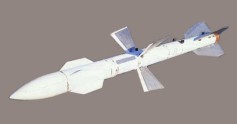 AA-10 ALAMO (R-27): The AA-10
"Alamo" was a contemporary of the American Sparrow AIM-7M
missile. The missile is equipped with a semi-active radar homing
head; although, several variants using passive IR and active RF are
known to exist. The AA-10 was used extensively by Russian and
Eastern Co-prosperity forces during the Global Civil War; however, the
missile was gradually phased out by the AA-12 in the early 21st
century.
AA-10 ALAMO (R-27): The AA-10
"Alamo" was a contemporary of the American Sparrow AIM-7M
missile. The missile is equipped with a semi-active radar homing
head; although, several variants using passive IR and active RF are
known to exist. The AA-10 was used extensively by Russian and
Eastern Co-prosperity forces during the Global Civil War; however, the
missile was gradually phased out by the AA-12 in the early 21st
century.
- PRIMARY PURPOSE: Anti-aircraft
- MISSILE SPEED: 3,000 kph
- RANGE: 80 km
- GUIDANCE: Semi-active radar
- DAMAGE: 2D6*10
- BLAST RADIUS: 40 feet
- RATE OF FIRE: One Missile
- STRIKE BONUS: +2 to strike
-
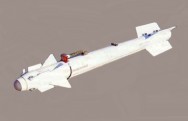 AA-11 ARCHER (R-73): The
premier short range all-aspect IR missile of the former Soviet Union,
Eastern Co-Prosperity Sphere Forces and EBSIS. The missile is
directly connected to the pilot's helmet which allows engagements
lateral to the aircraft.
AA-11 ARCHER (R-73): The
premier short range all-aspect IR missile of the former Soviet Union,
Eastern Co-Prosperity Sphere Forces and EBSIS. The missile is
directly connected to the pilot's helmet which allows engagements
lateral to the aircraft.
- PRIMARY PURPOSE: Anti-aircraft
- MISSILE SPEED: 2,000 kph
- RANGE: 40 km
- GUIDANCE: All aspect infrared
- DAMAGE: 1D6*10
- BLAST RADIUS: 30 feet
- RATE OF FIRE: One missile
- STRIKE BONUS: +3 to strike
- AA-12 ADDER (R-77): A Russian missile
similar to the American AIM-120 AMRAAM missile. The AA-12 is
inertially guided to the target from launch through mid-course and
terminally guided by its own onboard active RF seeker. The AA-12
missile was introduced during the global civil war of the mid 1990's
and became the premier medium range missile for the
Eastern-Co-Prosperity Sphere Forces.
- PRIMARY PURPOSE: Anti-aircraft
- MISSILE SPEED: 3,000 kph
- RANGE: 100 km
- GUIDANCE: Inertial with terminal active radar
- DAMAGE: 2D4*10
- BLAST RADIUS: 35 feet
- RATE OF FIRE: One missile or in volleys of
two
- NOTES: +4 to strike
- 2 x BOP-402 CHAFF/FLARE DECOY DISPENSERS: Two chaff flare
decoy
dispensers are located in two dispensers located in the rear of the
aircraft. Each
dispenser can hold up to 30 decoys apiece with the standard load out
consisting of 50% chaff bundles and 50% flares. The type
and number of each decoy is triggered manually by the pilot.
- PRIMARY PURPOSE: Anti-missile
- RANGE: 100 m
- RATE OF FIRE: Up to 10 decoys per attack
- PAYLOAD: 30 decoys per dispenser
- NOTES: In game play only chaff
bundles will affect RF missiles and flares affect IR missiles.
The player must declare after the missile strike, without knowledge of
the natural strike roll of the missile attack, which type of
decoy he is deploying. For each effective decoy deployed subtract
-3 from the natural die roll for dumb missiles (those with strike rolls
+2 or less), -2 from the natural die from for standard missiles (+3 to
strike), -1 from the natural die roll from intelligent missiles (+4 or
greater to strike). If the natural die roll, with out any strike
bonuses added falls below +5 then the decoys are effective and the
missile(s) will miss their intended target.
STANDARD EQUIPMENT FOR THE GRIPEN:
-
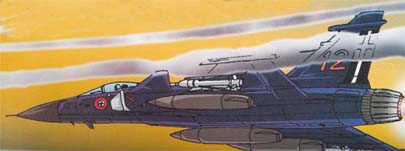 ACTIVE SENSOR JAMMER RB-74: Optional
ECM pod can be mounted on the wingtip hardpoints. Estimated
system effective
radiative power 20 dBW.
ACTIVE SENSOR JAMMER RB-74: Optional
ECM pod can be mounted on the wingtip hardpoints. Estimated
system effective
radiative power 20 dBW.
- AUTO-PILOT: The Gripen is equipped with a computerized
auto-pilot, allowing the pilot to relax or even sleep during long
voyages. The auto- pilot can be programmed with a single destination or
a complex flight plan involving multiple speeds, directions, and
destinations. The onboard computer will alert the pilot when the
fighter is near its destination, and can also be set to automatically
signal when sensors detect objects near the fighter.
- CHAFF AND FLARE DISPENSERS BOP-402: 30 chaff
and
30 flares in two dispensers located in two pylons underneath the wings,
see
entry above for further details.
- COMBAT COMPUTER WITH HUD DISPLAYS ERICSSON SDS-80:
The
combat computer
tracks and identifies specific enemy targets and displays them on a
heads up display. The radar and combat computer can identify and
track up to 15 targets simultaneously and engage with up to two
semi-active missiles.
- INFRARED SEARCH AND TRACK TARGETING SYSTEM:
The Gripen mounts a forward looking infrared search and tracking
targeting system in a small housing immediately ahead of the windshield
and laser ranging system. The system can be used to engage
inbound targets when use of the radar is prohibited because of
restricted use of radar emissions. The system has a range of 30
km and while in use the aircraft retains its strike bonus.
- INFRA-RED WARNING RECEIVER (IRWR):
Providing rear aspect protection from IR guided
missiles
- LASER TARGETING SYSTEM: System has a range of 50 km
and is used to increase the accuracy of onboard weapons.
- RADAR ERICSSON/BAE PS-05A X-BAND PULSE DOPPLER:
Detection radar
against 0 dBsm target 30 km. The radar has limited
multi-targeting capability being able to track up to 50 targets but can
engage only 4 at any given time.
- RADIO/VIDEO COMMUNICATION: Long range, directional
communications system with satellite relay capabilities. Range: 300
miles (960 km) or can be boosted indefinitely via satellite relay.
- RADAR-ABSORBING SKIN COVER: The Gripen makes use
of composite material which reduces the aircrafts passive radar cross
section.
- RADAR WARNING CELSIUSTECH (RWR):
Providing all aspect broadband protection from RF guided missiles.
- STANDARD SURVIVAL KIT: All EBSIS fighters come equipped
with a portable survival kit. Inside the small reinforced box is a
medium-sized flashlight, two hand flares, one rocket flare, a compass,
infrared distancing binoculars, a small mirror, a pocket knife,
dehydrated and concentrated food (can be stretched into a five day
supply for one person) and basic first aid items (aspirin, bandages,
disinfectants, etc.)
- TACTICAL LIFE SUPPORT SYSTEM: The Gripen's cockpit is
pressurized, and also provides additional air feeds to the pilot's
flight suit that provides him with pressurized breathing. The EBSIS
flight suit also contains an upper and lower g-suit that promotes blood
circulation even during high-g turns, thus decreasing the possibility
of pilot's blacking out in combat.
- TOWED DECOY AN/ALE-55: Fiber optic towed decoy
providing enhanced protection against RF guided surface to air missiles.
COMBAT BONUSES FOR JAS-39 (A,B) TRAINING:
- 2 actions per melee plus those of the pilot (and those of the
weapon systems officer, JAS-39B)
- Add one additional action at levels six and eleven.
- +1 to strike with 20mm Cannons
- +5 to dodge (+4 for JAS-39B)
- +15% on all piloting skill checks (+10% for JAS-39B)
COMBAT BONUSES FOR JAS-39 (C,D) TRAINING:
- 2 actions per melee plus those of the pilot (and those of the
weapon systems officer, JAS-39D)
- Add one additional action at levels six and eleven.
- +2 to strike with 20mm Cannons
- +6 to dodge (+5 for JAS-39D)
- +25% on all piloting skill checks (+20% for JAS-39D)
Random Hit Locations
When there is an equal chance of
hitting both sides from 1D6
- 1-3 hits the right side
- 4-6 hits the left
When there is a preferred side, roll
1D10
- 1-8 hits the preferred side
- 9-10 hits the opposite side
| Gripen |
FRONT
|
BACK
|
SIDES
|
TOP
|
BOTTOM
|
| Pilot's Compartment (Main Body) |
01-40 |
01-05 |
01-20 |
01-20 |
01-15 |
| Front
Stabilizers (Main Body) |
41-45 |
06-10 |
21-25 |
21-28 |
16-25 |
| Wings (Main Body) |
46-65 |
11-40 |
26-36 |
29-60 |
26-60 |
| Tail
(Main Body) |
66-70 |
41-50 |
37-55 |
61-65 |
- |
| Engine (Main Body) |
71-75 |
51-80 |
56-60 |
66-70 |
61-65 |
| 35mm Cannon (Main Body) |
76-78 |
81-83 |
61-63 |
- |
66-70 |
| Main Body |
79-00 |
84-00 |
64-00 |
71-00 |
71-00 |
REFERENCES USED IN THIS DESIGN
- Janes: JAS-39 "Gripen"
- Periscope: JAS-39 "Gripen"
Back to Mecha Home
 The JAS-39 "Gripen" was designed in the mid 1980's
to replace the aging Viggen and Drakens fighters and provide the first
"fourth-generation" multi-strike fighter to the Swedish Air
Force. As with all Swedish fighters, the Gripen is designed to
use small low-tech airbases scattered around the countryside and
take-off and land in less than 800 meters of unimproved automobile
roadways. The resultant fighter uses advanced avionics and the
close-coupled canard wing configuration common to the multinational
Euro-fighter, French Rafale, and the aborted Israeli Lavi. The
Gripen is composed primarily of a carbon-fiber composite construction
which makes up 25 percent of the airframe weight. The
design is not as stealthy as some other 4th generation fighters;
however, the fighters small size and reduced signature intakes have
reduced its overall radar cross section.
The JAS-39 "Gripen" was designed in the mid 1980's
to replace the aging Viggen and Drakens fighters and provide the first
"fourth-generation" multi-strike fighter to the Swedish Air
Force. As with all Swedish fighters, the Gripen is designed to
use small low-tech airbases scattered around the countryside and
take-off and land in less than 800 meters of unimproved automobile
roadways. The resultant fighter uses advanced avionics and the
close-coupled canard wing configuration common to the multinational
Euro-fighter, French Rafale, and the aborted Israeli Lavi. The
Gripen is composed primarily of a carbon-fiber composite construction
which makes up 25 percent of the airframe weight. The
design is not as stealthy as some other 4th generation fighters;
however, the fighters small size and reduced signature intakes have
reduced its overall radar cross section. MAXIMUM SPEED:
MAXIMUM SPEED:  AA-10 ALAMO (R-27): The AA-10
"Alamo" was a contemporary of the American Sparrow AIM-7M
missile. The missile is equipped with a semi-active radar homing
head; although, several variants using passive IR and active RF are
known to exist. The AA-10 was used extensively by Russian and
Eastern Co-prosperity forces during the Global Civil War; however, the
missile was gradually phased out by the AA-12 in the early 21st
century.
AA-10 ALAMO (R-27): The AA-10
"Alamo" was a contemporary of the American Sparrow AIM-7M
missile. The missile is equipped with a semi-active radar homing
head; although, several variants using passive IR and active RF are
known to exist. The AA-10 was used extensively by Russian and
Eastern Co-prosperity forces during the Global Civil War; however, the
missile was gradually phased out by the AA-12 in the early 21st
century.
 AA-11 ARCHER (R-73): The
premier short range all-aspect IR missile of the former Soviet Union,
Eastern Co-Prosperity Sphere Forces and EBSIS. The missile is
directly connected to the pilot's helmet which allows engagements
lateral to the aircraft.
AA-11 ARCHER (R-73): The
premier short range all-aspect IR missile of the former Soviet Union,
Eastern Co-Prosperity Sphere Forces and EBSIS. The missile is
directly connected to the pilot's helmet which allows engagements
lateral to the aircraft.
 ACTIVE SENSOR JAMMER RB-74: Optional
ECM pod can be mounted on the wingtip hardpoints. Estimated
system effective
radiative power 20 dBW.
ACTIVE SENSOR JAMMER RB-74: Optional
ECM pod can be mounted on the wingtip hardpoints. Estimated
system effective
radiative power 20 dBW.